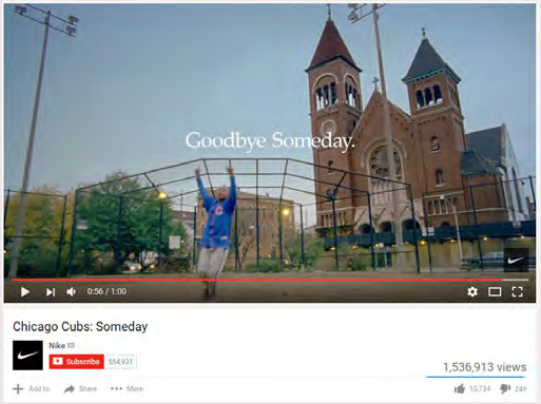19.7: Estudio de caso - Nike Chicago Cubs Algún día
- Page ID
- 67196
Resumen de una línea
Nike creó una celebración en video de la primera victoria de los Chicago Cubs en la Serie Mundial desde 1908.
El reto
Los Cachorros de Chicago no habían ganado una Serie Mundial en 107 años, por lo que su victoria en 2016 ofreció a las marcas la oportunidad de mostrar su apoyo y ganar la buena voluntad del cliente. Nike quería entrar en esta ocasión histórica.
La solución
Nike pasó toda la semana reuniendo a Chicago con una campaña “Make Someday Today” que incluyó vallas publicitarias, redes sociales y más. En la noche del juego, Nike compró la primera ranura publicitaria después del juego y la utilizó para emitir su anuncio de video sobre un niño que sueña con ganar la Serie Mundial.
Subieron el video a YouTube. Debido a que la marca en el video es sutil (principalmente la colocación del producto en los zapatos y guantes del niño), el video no es explícitamente promocional y por lo tanto es más probable que atraiga a los espectadores en línea. Esto lo convierte en uno de los raros ejemplos de un spot televisivo que funciona igual de bien en línea. Siguieron algunos principios importantes de mejores prácticas al crear este video:
- Producir un gran contenido de video con un enfoque en el valor para el consumidor en lugar de para la marca
- Segmentación efectiva
- Relevancia. Fue cronometrado bien y fue emocionalmente relevante para su público objetivo
- Involucrar con los usuarios en las redes sociales para atraer tráfico al video y compartir el video en las redes sociales también
- Investigación efectiva para entender lo que atraería a su mercado objetivo.
Los resultados
El video obtuvo 1.5 millones de reproducciones en una semana. También ganó una gran cantidad de medios ganados a través de la cobertura deportiva, artículos de noticias que mencionaban el video y las acciones en redes sociales, todos los cuales fueron increíblemente positivos.



